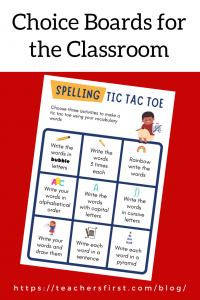Over 20 years ago, as a new teacher, I struggled to grade 28 submissions for each assignment I gave my students. Finally, I realized that I had a choice to make. Do I continue with a one size fits all approach to learning in my classroom, or do I place more responsibility in the hands of my students and give them choices? We can all agree that when you have options on how to do something, it’s more motivating than completing something decided for you. Student choice in the classroom increases engagement, motivation, and ownership of their learning. Choice boards are one way to incorporate options into your classroom.
A choice board is an organizer that allows your students to choose what they learn, how they interact with the content, how to demonstrate their knowledge of the learning objectives, or a combination of all three. A choice board can empower students and allow teachers to facilitate a tiered approach to differentiated instruction with several formats to focus on students’ specific learning needs, interests, and skills. In addition, student agency is a significant benefit of implementing choice boards in the classroom. Below are tips for designing, organizing, and implementing choice boards in your classroom.
Design
It’s critical to begin with the end in mind when designing choice boards for your students. First, identify the goal or core concepts the students must complete. Next, list student interests, preferences, tech tools, and resources to add to the board for student selections before planning the activities. It may be helpful to review the tools and descriptions on the TeachersFirst Edge before planning activities to engage and empower the students. For example, students could create a digital story with Bookemon (reviewed here) or an infographic with Snappa (reviewed here).
Organization
Many choice boards utilize a three-by-three grid with links to activities in the nine squares. The students may have a requirement to complete certain activities or randomly pick activities. One square can also be a “FREE CHOICE,” allowing students to create an activity of their choice to meet the goal of the choice board. Tic-Tac-Toe style boards in a grid format also enable students to complete three activities diagonally, across, or vertically. There’s an opportunity to be creative as a teacher with the organization of the board, but make sure to select formats that best meet the activities’ goals.
Another popular design to organize choice boards is to assign colors or point values to the choices. Students must complete a series of colors or earn a total point value with the activity selection. These options allow the teacher to offer differentiated activities for the students. For more ideas on differentiating choice boards in the classroom, check out this OK2Ask archive on Engage & Inspire: Choice Boards for Differentiation. Yet another organization technique is to create a playlist like a YouTube channel or menu options where students must select an appetizer, main course, and dessert.
Tech Tools
SlidesMania is a fantastic resource with templates to create choice boards using Google Slides or PowerPoint. Wakelet (reviewed here) is another resource to organize choice board activities, learning menus, or student playlists. An example Wakelet on dialogue shows a way to set up choices with this tool or use Genially (reviewed here) to level up your choice board engagement. Also, this OK2Ask Twitter Chat archive on Student-Centered Learning Ideas with Playlists and Choice Boards has many resources and ideas for choice boards.
We know that the one-size-fits-all approach to education is not ideal for best meeting students’ needs. Choice boards can provide experiences that allow students to own their learning and decide the path of their learning process. What are your favorite strategies and resources to build choice boards? We’d love to hear about them in the comments below!



My elementary students really enjoy having choice in what and when they learn. Based on the daily demands of our curriculum pacing, it can feel challenging to give them this control. Choice boards have been a life saver! They have changed the way that students practice problem solving, basic skills and engage in creative responses to writing and reading activities. Your article is so helpful in breaking down the components of a Choice Board and then providing excellent advice on their design and organization. I will definitely put your ideas to good use.